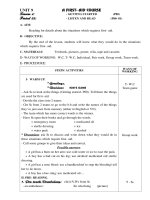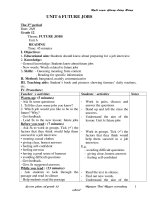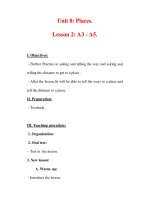GIAO AN ANH 8 UNIT 7 SKILLS 1
Bạn đang xem bản rút gọn của tài liệu. Xem và tải ngay bản đầy đủ của tài liệu tại đây (1.27 MB, 21 trang )
<span class='text_page_counter'>(1)</span>ENGLISH 8 Unit 7. POLLUTION. Period 60. SKILLS 1 (Page 12).
<span class='text_page_counter'>(2)</span> Unit 7. POLLUTION. Period 60 - SKILLS 1. I. VOCABULARY - groundwater (n) the water beneath the earth’s surface : nước ngầm - pesticide (n) : thuốc trừ sâu - herbicide (n): thuốc diệt cỏ - “point sourse” pollution (n): ô nhiễm có nguồn - “ non-point sourse” pollution: ô nhiễm không nguồn (nguồn phân tán).
<span class='text_page_counter'>(3)</span> II. READING.
<span class='text_page_counter'>(4)</span> Look at the pctures, ask and answer questions to find out the differences between the two pictures:. Example: T (picture A): Are there five ducks in your picture? S (picture B): Yes, there are. Are the ducks black in your picture? T: No, they aren’t. They’re white. ........... What do the pictures tell you? They tell about water pollution. What causes water pollution in picture B? Factories dump industrial waste into the lake..
<span class='text_page_counter'>(5)</span> 2. Mi and Nick have decided to give a presentation on water pollution to the class. Read what they have prepared and answer the questions Water pollution is the contamination of bodies of water such as lakes, rivers, oceans, and groundwater (the water beneath the Earth’s surface). It is one of the most serious types of pollution. Water pollution can have many different causes. Factories dump industrial waste into lakes and rivers. Sewage from households is another cause. Farms using pesticides to kill insects and herbicides to kill weeds can also lead to water pollution. These factors cause “point source” pollution while pollutants from storm water and the atmosphere result in “non-point source” pollution. Water pollution can have dramatic effects. In many poor nations, there are frequent outbreaks of cholera and other diseases because of people drinking untreated water. Humans can even die if they drink contaminated water. Polluted water also causes the death of aquatic animals such as fish, crabs, or birds. Other animals eat these dead animals and may also get sick. In addition, herbicides in water can kill aquatic plants and cause further damage to the environment. So what should we do to reduce water pollution?.
<span class='text_page_counter'>(6)</span> EXERCISE 2: Answer the questions: 1. What does the second paragraph tell you about? 2. What does the first paragraph tell you about? 3. What is groundwater? 4. What are point source pollutants? 5. What are non-point source pollutants? 6. Why do people use herbicides?.
<span class='text_page_counter'>(7)</span> EXERCISE 2: Answer the questions:. 1. The second paragraph tells about the causes of water pollution. 2. The third paragraph tells about the effects of water pollution. 3. It’s the water beneath the Earth’s surface.. 4. They are industrial waste, sewage, pesticides, and herbicides. 5. They are pollutants from storm water and the atmosphere. 6. They use herbicides to kill weeds..
<span class='text_page_counter'>(8)</span> Exercise 3. Read the text again and complete the notes about the effects of water pollution. Fill each blank with no more than three words. 1. If the drinking water is untreated, an outbreak cholera of .............. may happen. die 2. People drinking contaminated water may ............. 3. Fish, crabs or birds may also die because polluted water of ........................ 4. Other animals may become ill if they eat death the ................ animals. aquatic plants . 5. Herbicides kills both weeds and .........................
<span class='text_page_counter'>(9)</span> III. SPEAKING.
<span class='text_page_counter'>(10)</span> Complete the diagram of water pollutipon. Use the information form the text for the causes and effects and your group’s ideas for the sollutions:. Water pollution: Definition: _____. EFFECTS •Humans: ____ •Animals: ____ •Plants: _____. SOLUTIONS - __________ - __________ - __________. CAUSES - Point source pollutants: - Non-point source pollutants:.
<span class='text_page_counter'>(11)</span> - Definition: the contamination of lakes, rivers, oceans or groundwater, usually by human activities. - Causes: + Sewage and waste water from families + Chemical waste from factories + Pesticides and herbicides - Effects: + Humans: diseases/ die + Animals: death of aquatic animals + Plants: kill aquatic plants - Sollutions: - Factories dump industrial waste. + Give heavy fines to companies that are found doing this. + Educate companies about the environment. + Give tax breaks to companies that find ‘clean’ ways to dispose of their waste. - Sewage and waste water: + Never throw rubbish away. + Advise everyone not to throw trash, put it into a trash bin and sort it. -Pesticides and chemicals + If you use chemicals and pesticides for your gardens and farms, be mindful not to overuse pesticides and fertilizers. ......
<span class='text_page_counter'>(12)</span> Make a presentation about water pollution based on the diagram.
<span class='text_page_counter'>(13)</span> * Matching: Match the industrial causes of water pollution and the effects: 1. Sulphur (Lưu huỳnh. A. This pollutant has cancer-causing properties. When inhaled, it can cause illnesses such as asbestosis (bệnh bụi amian) and some types of cancer.. 2. Asbestos (Amiăng). B. Do not dissolve in water. It is also harmful to fish and marine birds.. 3. Lead and Mercury (Chì và thủy ngân): 4. Oils (Dầu). C. This is a non-metallic substance (chất phi kim loại) that is harmful to marine life. D. These are metallic elements, very poisonous and can cause environmental and health problems for humans and animals..
<span class='text_page_counter'>(14)</span> What should you do to keep the environment unpolluted?.
<span class='text_page_counter'>(15)</span> We shouldn’t throw trash everywhere. We should put it into a trash bin and sort it..
<span class='text_page_counter'>(16)</span> We should reuse and recycle things. By doing that, we can reduce the amount of garbage we produce..
<span class='text_page_counter'>(17)</span> We should use environmentally-friendly bags when we go to the market, clean up our school, collect garbage and plant more green trees. By doing these activities, our surroundings will be cleaner and greener..
<span class='text_page_counter'>(18)</span> We shouldn’t burn trash. Burning trash will pollute the air, it puts pollutants like carbon dioxide (CO2) and dioxins to the air. These are very poisonous, they can cause cancer and many diseases..
<span class='text_page_counter'>(19)</span> We should go to school by bike or on foot instead of going by motorbikes or by cars. We can reduce the amount of smoke to the air by doing this..
<span class='text_page_counter'>(20)</span> We should persuade our relatives and neighbors to use cloth bags or environmentally-friendly bags instead of plastic bags. Plastic bags are very hard to dissolve. They will cause pollution that lasts for a very long time..
<span class='text_page_counter'>(21)</span> THANK. FOR. YOU Your. ATTENTION.
<span class='text_page_counter'>(22)</span>









